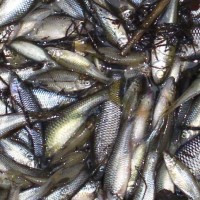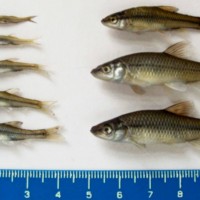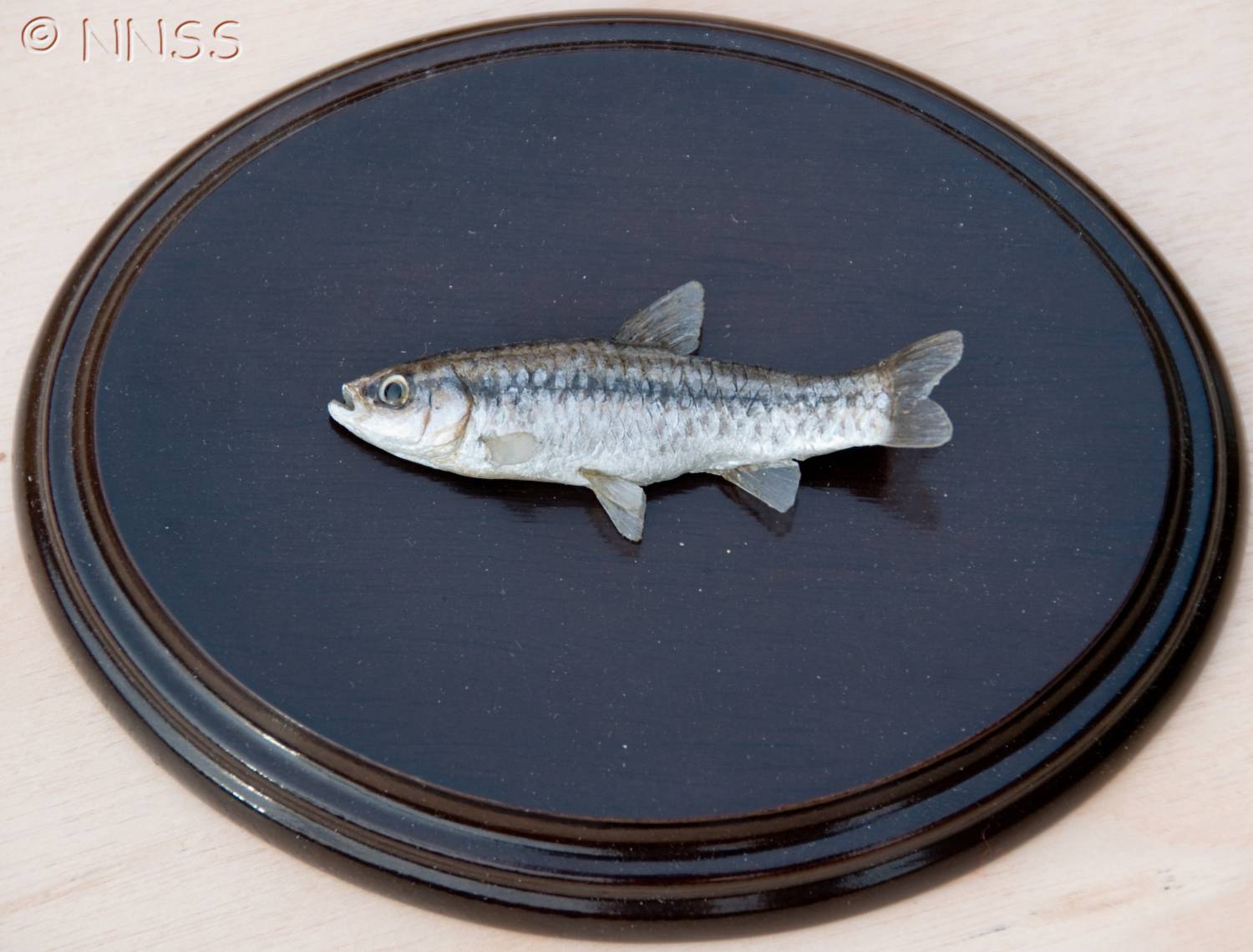
Topmouth Gudgeon - Pseudorasbora parva
Expand and collapse the sections below by clicking on the title or + / - icons.
Short description of Pseudorasbora parva, Topmouth Gudgeon
Elongate, slightly flattened sides, resembling Gobio. To 110 mm. Mouth in top position. Dorsal and anal fins short; caudal fin large, deeply incised. Grey back, pale sides/belly. Juveniles with dark stripe along sides. Characteristic lunate spots in caudal part of scales. Fins pale; darker stripe running obliquely backwards on dorsal fin. During spawning, males darker with tubercles on head, females paler.
Impact summary: Pseudorasbora parva, Topmouth Gudgeon
Competition with native and farmed fish for food, space and spawning habitat. May deplete native fish populations and reduce commercial fish productivity. Predation of fish fry/eggs and invertebrates. Depletion of zooplankton can increase phytoplankton abundance and hence eutrophication. Disease vector e.g. Spherotecum destruens.
Habitat summary: Pseudorasbora parva, Topmouth Gudgeon
Found in a wide variety of habitats; most abundant in well vegetated small channels, ponds and small lakes. Adults occur preferentially in cool, shallow water, either still or slow-flowing, especially with abundant macrophytes.
Overview table
| Environment | Freshwater |
|---|---|
| Species status | Non-Native |
| Native range | Anhui, Beijing, Fujian, Gansu, Hebei, Heilongjiang, Henan, Hubei, Hunan, Jiangsu, Jiangxi, Jilin, Liaoning, Nei Mongol, Ningxia, Qinghai, Shaanxi, Shandong, Shanxi, Sichuan, Tibet, Zhejiang, Hokkaido, Honshu, Kyushu, Nansei-shoto, North Korea, South Korea, Khabarovsk, Primorye, Taiwan |
| Functional type | Predator |
| Status in England | Non-Native |
| Status in Scotland | |
| Status in Wales | |
| Location of first record | Outflow stream, Crampmoor fishery (Hampshire) |
| Date of first record | 1990 |
Origin
Topmouth gudgeon originates from East Asia, including the basins of the rivers Amur, Yang-tze, Huang-ho, Japanese islands (Kiusiu, Sikoku and the southern and central parts of Honsiu), western and southern parts of the Korean Peninsula and Taiwan (Minkiang river system).
First Record
Introduced in southern England in the mid-1980s, with the first record in 1990 from the outflow stream of Crampmoor Fishery in Hampshire; note that this facility was also the source of the introduction of Sunbleak or Belica Leucaspius delineatus.
Pathway and Method
Introduced as an ornamental species with subsequent escapes into natural waters. The small adult size facilitates escape from enclosed stillwaters and quick colonisation of connected waterbodies. For example, this is how topmouth gudgeon colonised Tadburn Lake, which drains the original introduction site and joins the River Test approximately 4km downstream. Some introductions may be as contaminants with other ornamental fish with possible further spread by use as baitfish.
Species Status
A population in Cumbria (Ratherheath Tarn) was eradicated in 2005 using rotenone. An introduction in the London area (Epping Forest) was eradicated by depletion. A small number of specimens found in the rivers Cole and Lower Lee, and specimens of Leuciscus souffia reported in the River Thames were probably topmouth gudgeon although establishment of these populations has not been confirmed. Reproducing population has been reported in an ornamental lake in the Chilterns, England. Additionally an introduction of topmouth gudgeon was noted at a commercial fishery in Kent in 2008. Eradication of this species has been shown to result in the increased growth and production of native fishes in Lake District of north-west England, illustrating the impact of the species' introduction on native fish communities.
Dispersal Mechanisms
Following escape from isolated water-bodies, natural dispersal may be swift with rapid reproduction, even though the spread may only be over a few km initially. The use of a wide range of spawning substrata means that eggs can be laid on surfaces such as floating macrophytes, boats and floating plastic fenders, any of which may facilitate accidental spread between waterways and waterbodies. Spread may occur by eggs being transported on angling equipment, or by escape of fish used as live bait. Topmouth gudgeon has the potential to spread rapidly due to a combination of small body size, broad environmental/habitat tolerance, hiding in densely vegetated parts of water bodies, multi-litter spawning and parental care.
Reproduction
Spawning takes place when one year old, requiring a water temperature of 15-19°C (May-August in its native range, sometimes earlier in Europe). Females produce from a few hundred to a few thousand eggs. Spawning is multi-litter (up to four times per year) and takes place in the littoral zone. The eggs are laid on plants, sand, stones, mollusc shells and other substrata, which the female cleans prior to egg-laying. Up to several dozen eggs are laid at one time. One male may spawn with a small number of females consecutively. The male guards the eggs until hatching, and aggressively drives away other, often larger fishes.
Sexual dimorphism becomes pronounced during spawning. In males breeding tubercles appear on the head, most (approx. 14) being around the front with a few (approx. 4) on the lower lip. Males darken distinctly, with their fins becoming black and the operculum becoming violet. Females become clearly paler.
Known Predators/Herbivores
General piscivory, especially predatory fish such as pike, pikeperch and perch.
Resistant Stages
None known.
Habitat Occupied in GB
Found in a wide variety of habitats; most abundant in well vegetated small channels, ponds and small lakes. Often associated in GB with isolated water-bodies such as ornamental ponds and lakes, plus water-courses and water-bodies connected to areas of introduction such as commercial fisheries.
Widespread but scattered in England and (to a lesser extent) Wales, mainly in isolated water-bodies but also some connected systems. Recorded in Wales.
Environmental Impact
Competes for food with native and farmed fish species, plus competition for space and spawning habitat, especially where it is abundant; densities of 60 or more fish per square metre have been recorded. In one study, in the presence of P. parva, no young-of-the-year native fish were detected in any netting or electro-fishing exercises and the growth of native fish was shown to be severely stunted. Direct impacts via predation e.g. on invertebrates and fish fry/eggs may occur. It may seriously deplete (or even eradicate) native fish and invertebrate populations as well as reducing productivity of farmed fish. It consumes zooplankton (e.g. phytoplankton-grazing crustaceans) which results in an increase in phytoplankton abundance, and subsequent increase in eutrophication. A vector of infectious diseases (e.g. Spherotecum destruens), thus constituting a serious threat to both native and farmed fishes in Europe. In continental Europe, topmouth gudgeon is reported to act as a vector for the parasites Anguillicola crassus and Clinostomum complanatum and also as a carrier of Pike Fry Rhabdovirus (PFR).Research suggests the possibility of hybridisation albeit with another non-native species, the Belica or Sunbleak Leucaspius delineatus.
Health and Social Impact
No direct health effects, although potential impacts through increased eutrophication. Also, potential loss of amenity value through damage to native populations and ecosystems.
Nuisance species, avoided by anglers as a non-target species known to take bait.
Economic Impact
Reduced productivity of fish farms and native fisheries.
Costs of eradication and subsequent management to reverse damage to ecosystems.
Identification
See general references.
Biology, ecology, spread, vectors
Adamek, Z., Navratil, S., Palikova, M. & Siddiqui, M.A. (1996) Pseudorasbora parva Schlegel, 1842: Biology of non-native species in the Czech Republic. In: Proceedings of scientific papers to the 75th Anniversary of Foundation of the Research Institute of Fish Culture and Hydrobiology (ed. Flajshans, M.), pp. 143-152.
Araujo, F.G., Bailey, R.G. & Williams, W.P. (1999) Spatial and temporal variations in fish populations in the upper Thames estuary. Journal of Fish Biology, 55, 836-853.
Davies, G. (2009) Topmouth gudgeon: the deadly invader. Fish (The Magazine of the Institute of Fisheries Management), 94, 17-20.
Domaniewski, J. & Wheeler, A.C. (1996) The topmouth gudgeon has arrived. Fish (The Magazine of the Institute of Fisheries Management), 43, 40.
Pinder, A.C. & Gozlan, R.E. (2003) Sunbleak and topmouth gudgeon - two new additions to Britain's freshwater fishes. British Wildlife, 15(2), 77-83.
Zięba, G., Copp, G.H., Davies, G.D., Stebbing, P., Wesley, K.J. & Britton, J.R. (2010) Recent releases and dispersal of non-native fishes in England and Wales, with emphasis on sunbleak Leucaspius delineatus (Heckel, 1843). Aquatic Invasions, 5(2), 155-161.
Management and impact
Adamek, Z. & Sukop, I. (2000) Vliv střevličky východni (Pseudorasbora parva) na parametry rybničniho prostředi. Biodiverzita ichtiofauny ČR, 3, 37-43.
Britton, J.R., Davies, G.D. & Brazier, M. (2009) Eradication of the invasive Pseudorasbora parva results in increased growth and production of native fishes. Ecology of Freshwater Fish, 18, 8-14.
Gozlan, R. E. & Beyer, K. (2006) Hybridisation between Pseudorasbora parva and Leucaspius delineatus. Folia Zoologica, 55, 53-60.
Gozlan, R.E., St-Hilaire, S., Feist, S.W., Martin, P. & Kent, M.L. (2005) Disease threat to European fish. Nature, 435, 1046.
General
Bănărescu, P. (1999) Pseudorasbora parva (Temminck & Schlegel 1846). In: Bănărescu, P. (ed.) – The Freshwater Fishes of Europe. 5.I. Cyprinidae 2/I. Aula Verl., Wiesbaden.
Fishbase Pseudorasbora parva. [accessed 15/11/2010].
Witkowski, A. (2006) NOBANIS – Invasive Alien Species Fact Sheet – Pseudorasbora parva. [accessed 15/11/2010].
https://www.cabi.org/isc/datasheet/67983
https://secure.fera.defra.gov.uk/nonnativespecies/downloadDocument.cfm?id=243
Alert status
Topmouth Gudgeon, Pseudorasbora parva is an Alert Species
Find more information about this alert and the full list of alert species.
Spotted this species?
Distribution map
View the Distribution map for Topmouth Gudgeon, Pseudorasbora parva from NBN Atlas

Native range map
View an interactive native range map for Topmouth Gudgeon, Pseudorasbora parva
Risk assessment
Risk assessment for Pseudorasbora parva. See a full list of non-native species Risk assessments.
Legislation
Topmouth Gudgeon, Pseudorasbora parva, is a Species of Special concern. Read more about Non-native species legislation.

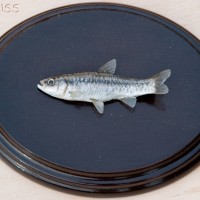
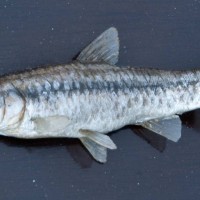
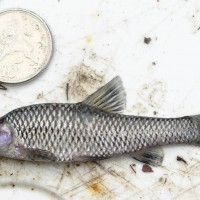
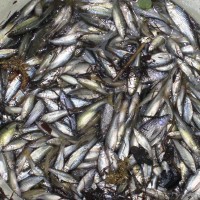
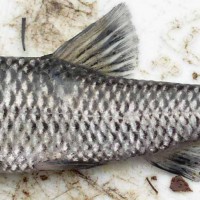
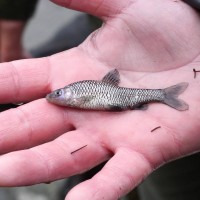
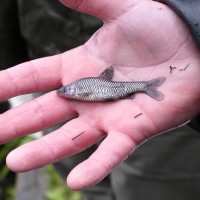
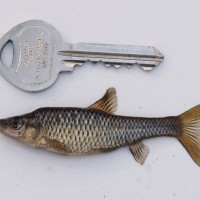
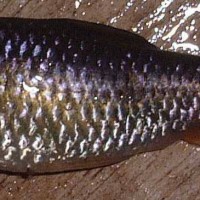
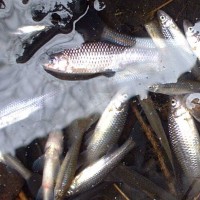
__FillMaxWzIwMCwyMDBd.jpg)
